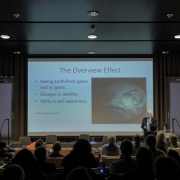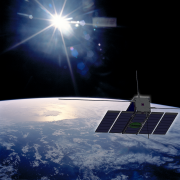Jamboree on the Air 2023
Online EME relay station
 Friday, 20 October, 2023 and Saturday, 21 October, 2023, the Dwingeloo Radio Telescope will once again function as an online ‘Earth Moon Earth’ (EME) relay station. Scouting groups will also send signals to the moon with their self-built antennas during the international ‘Jamboree On The Air’(JOTA).
Friday, 20 October, 2023 and Saturday, 21 October, 2023, the Dwingeloo Radio Telescope will once again function as an online ‘Earth Moon Earth’ (EME) relay station. Scouting groups will also send signals to the moon with their self-built antennas during the international ‘Jamboree On The Air’(JOTA).
Due to its enormous sensitivity, the Dwingeloo telescope is very suitable for receiving the extremely weak EME signals. These signals are offered over the internet by means of the CAMRAS webSDR. Via this link: 70 cm EME you can watch, provided you have installed the special decoder software WSJT-X. The signal from the webSDR enters the said software via a virtual audio cable. You should set the audio level to approximately “30dB” (“green”). In WSJT-X, the scouts use the mode “JT65” and “sub B” and at the same time the option “EME delay” must also be enabled so that the required 2.5 second delay is used. This delay is necessary to account for the duration of the lunar echoes.
Test session
The radio telescope will be online on Friday, October 20, 2023 between 14:00 UTC and approximately 19:00 UTC so that the JOTA participants can test their antennas and equipment again prior to the official opening of the JOTA. Unfortunately, the moon has already set again before this official opening and therefore the real JOTA EME connections will have to wait until Saturday.
JOTA
On Saturday, October 21, 2023, the radio telescope will be online between 15:00 UTC and approximately 20:00 UTC so that JOTA participants can send messages to each other via the moon. The frequency on which the JOTA groups broadcast is, as last year, 432.050 MHz. Unfortunately, the elevation, that is, the height, of the moon is low during JOTA this year. This only reaches a maximum of 10 degrees above the horizon. This will often make it more difficult to find a good spot where the antenna can ‘see’ the moon. This is necessary because obstacles, such as buildings or trees, can cause additional attenuation of the signal.
Of course non JOTA stations can also use this opportunity to test their equipment, which may normally be not really suitable for EME, for QRP EME. Consider, for example, a single Yagi antenna with sufficient elements with approximately 50W of transmitting power. In many cases this is sufficient in this particular situation because the Dwingeloo telescope is such a sensitive receiver. It’s probably fun to try this too?
We kindly ask the non-JOTA and especially high power “QRO” EME stations to transmit around 432.100 MHz or higher so that the weak JOTA stations will not be hindered!
More info
The CAMRAS crew that provides the online streaming of the JOTA EME signals consists of Michel Arts (PE1NVK) and Simon Bijlsma (PA7SB).
Further information.
Download a report by Frans De Jong (PE1RXJ) of the test session of September 2, 2023 here(in Dutch).
Fifteen years ago, this JOTA-EME project was initiated by Frans de Jong, who wrote a construction description (in Dutch) for the required ’23 elements Long Yagi voor de 70cm band’. See also the page JOTA-JOTI and the blog post about it from 2008 (also both in Dutch).





 CC BY-NC-ND 2.0 NASA / Thomas Pesquet
CC BY-NC-ND 2.0 NASA / Thomas Pesquet




